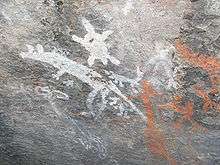Indigenous Australian art
Indigenous Australian art includes art made by Aboriginal Australian and Torres Strait Islander peoples of Australia, including collaborations with others. It includes works in a wide range of media including painting on leaves, bark painting, wood carving, rock carving, watercolour painting, sculpting, ceremonial clothing and sand painting; art by Indigenous Australians that pre-dates European colonisation by thousands of years, up to the present day.

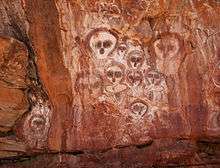
Traditional Indigenous art
There are several types of and methods used in making Aboriginal art, including rock painting, dot painting, rock engravings, bark painting, carvings, sculptures, and weaving and string art. A variety of colours are used, except for red, which symbolises blood and is only used in other types of painting.
Rock painting
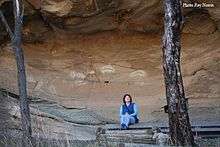
Aboriginal art includes a range of styles of rock painting:
- The cross-hatch and X-ray art from the Arnhem Land and Kakadu regions of the Northern Territory, in which the skeletons and viscera of the animals and humans portrayed are drawn inside the outline, as if by cross section.
- Dot-painting from the Central and Western Deserts through which intricate patterns, totems and stories are created using dots.
- Stencil art, particularly using the motif of a hand print.
- Wandjina painting from the Kimberleys
Australian Aboriginal art is the oldest unbroken tradition of art in the world. The oldest firmly dated rock art painting in Australia is a charcoal drawing on a rock fragment found during the excavation of the Narwala Gabarnmang rock shelter in south-western Arnhem Land in the Northern Territory. Dated at 28,000 years, it is one of the oldest known pieces of rock art on Earth with a confirmed date. Rock art, including painting and engraving or carving, can be found at sites throughout Australia. Rock paintings appear on caves in the Kimberley region of Western Australia known as Bradshaws. They are named after Joseph Bradshaw, who first reported them in 1891. To Aboriginal people of the region they are known as Gwion Gwion[1] or Giro Giro.[2] Other painted rock art sites include Laura, Queensland,[3] Ubirr, in the Kakadu National Park,[4] Uluru,[5] and Carnarvon Gorge.[6]
Aboriginal rock art has been around for a long period of time, with the oldest examples, in Western Australia's Pilbara region and the Olary district of South Australia, estimated to be up to around 40,000 years old.[7] Examples have been found that are believed to depict extinct megafauna such as Genyornis[8] and Thylacoleo in the Pleistocene era[9] as well as more recent historical events such as the arrival of European ships.[10]
Rock engravings
Rock engraving depends on the type of rock being used. Many different methods are used to create rock engravings. There are several different types of rock art across Australia, the most famous of which is Murujuga in Western Australia, the Sydney rock engravings around Sydney in New South Wales, and the Panaramitee rock art in Central Australia. The Toowoomba engravings, depicting carved animals and humans, have their own peculiar style not found elsewhere in Australia.
The rock art at Murujuga is said to be the world's largest collection of petroglyphs[11] and includes images of extinct animals such as the thylacine. Activity prior to the last ice age until colonisation is recorded.
Papunya art
Papunya art consists of various paint colours like yellow (representing the sun), brown (the soil), red (desert sand) and white (the clouds and the sky). These are traditional Aboriginal colours. Papunya paintings can be painted on anything, although traditionally they were painted on rocks, in caves, etc. The paintings were mostly images of animals or lakes, and the Dreamtime. Stories and legends were depicted on caves and rocks to represent the artists' religion and beliefs.
On modern artwork, dots are generally applied with bamboo satay sticks. The larger flat end of bamboo satay sticks are more commonly used for single application of dots to paintings, but the sharp pointier end is used to create fine dots. To create superimposed dotting, artists may take a bunch of satay sticks, dip the pointy ends into the paint and then transfer them onto the canvas in quick successions of dotting.[12]
Stone arrangements
Aboriginal stone arrangements are a form of rock art constructed by Aboriginal Australians. Typically they consist of stones, each of which may be about 30 cm in size, laid out in a pattern extending over several metres or tens of metres. Each stone is well-embedded into the soil, and many have "trigger-stones" to support them. Particularly fine examples are in the state of Victoria, where some examples have very large stones. For example, the stone arrangement at Wurdi Youang consists of about 100 stones arranged in an egg-shaped oval about 50 metres (160 ft) across. The appearance of the site is similar to that of the megalithic stone circles found throughout Britain (although the function and culture are presumably completely different). Although its association with Aboriginal Australians is well-authenticated and beyond doubt, the purpose is unclear, although it may have a connection with initiation rites. It has also been suggested that the site may have been used for astronomical purposes.[13] Smaller stone arrangements are found throughout Australia, such as those near Yirrkala, which depict accurate images of the praus used by Macassan Trepang fishermen and spear throwers.
Wood carvings (Punu)
Wood carving has always been an essential part of Aboriginal culture, requiring wood, sharp stone to carve, wire and fire. The wire and fire were used to create patterns on the object by heating the wire with the fire and placing it on the wood carving.
Wood carvings such as those by Central Australian artist Erlikilyika shaped like animals, were sometimes traded to Europeans for goods. The reason Aboriginal people made wood carvings was to help tell their Dreaming stories and pass on their group's lore and essential information about their country and customs. They were also used in ceremonies, such as the ilma.
Aboriginal people from the Tiwi Islands traditionally carved pukumani grave posts,[14] and since the 1960s have been carving and painting iron wood figures.[15]
Textiles
In most Pacific areas the men oversee the art and architecture; the women oversee the art in felted cloth they would make from tree bark and plants. The art in clothing is supervised by the head woman in charge of the production. These detailed cloths were worn for rituals; each represented wealth and rank in the group. The scared clothing is also used in trade goods and social and political relationships. Wearing the textile then removing it and giving it to another person helped to bond or reinforce friendship or alliances.[16]
Baskets and weaving
Baskets, sometimes coiled baskets, were created by twisting bark, palm-leaf, and feathers; some of the baskets were plain and some were created with feather pendants or feathers woven in the frame of the basket. The artists used mineral and plant dyes to color the palm-leaves and bark of the hibiscus. These string bags and baskets were used in ceremonies for religious and ritual needs; the baskets might have been also used for carry things back to the village.[17]
Basket weaving has been traditionally practised by the women of many Aboriginal Australian peoples across the continent for centuries.[18][19][20][21]
Jewellery
Aboriginal people created shell pendants which were considered high value and often used for trading goods. These shells were attached to string, which was handmade from human hair and sometimes covered with a type of grease and red ochre. This jewellery would sometimes be hung around a man’s neck or waist for use during ceremonies.[22]
.
Symbols
Certain symbols within the Aboriginal modern art movement retain the same meaning across regions although the meaning of the symbols may change within the context of a painting. When viewed in monochrome other symbols can look similar, such as the circles within circles, sometimes depicted on their own, sparsely, or in clustered groups. Depending upon the group of which the artist is a member, symbols such as campfire, tree, hill, digging hole, waterhole, or spring can vary in meaning. Use of the symbol can be clarified further by the use of colour, such as water being depicted in blue or black.
Many paintings by Aboriginal artists, such as those that represent a Dreaming story, are shown from an aerial perspective. The narrative follows the lie of the land, as created by ancestral beings in their journey or during creation. The modern day rendition is a reinterpretation of songs, ceremonies, rock art and body art that was the norm for many thousands of years.
Whatever the meaning, interpretations of the symbols should be made in context of the entire painting, the region from which the artist originates, the story behind the painting, and the style of the painting, with additional clues being the colours used in some of the more modern works, such as blue circles signifying water.[23]
Religious and cultural aspects of Aboriginal art
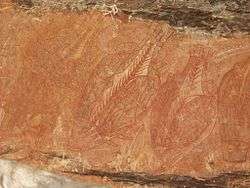
Some natural sites were sacred to them, and were also the location where seasonal rituals were performed. During these rituals the Aboriginal people created art such as feather and fibre objects, they painted and created rock engravings, and also painted on bark of the Eucalyptus tetrodonta trees. While stories differed among the clans, language groups, and wider groups, the Dreaming (or Jukurrpa) is common to all Aboriginal peoples. As part of these beliefs, during ancient times mythic Aboriginal ancestor spirits were the creators of the land and sky, and eventually became a part of it. The Aboriginal peoples' spiritual beliefs underpin their laws, art forms, and ceremonies. Traditional Aboriginal art almost always has a mythological undertone relating to the Dreaming.
Wenten Rubuntja, an Indigenous landscape artist, says it is hard to find any art that is devoid of spiritual meaning:
Doesn't matter what sort of painting we do in this country, it still belongs to the people, all the people. This is worship, work, culture. It's all Dreaming. There are two ways of painting. Both ways are important, because that's culture. – source The Weekend Australian Magazine, April 2002
Story-telling and totem representation feature prominently in all forms of Aboriginal artwork. Additionally, the female form, particularly the female womb in X-ray style, features prominently in some famous sites in Arnhem Land. X-ray styles date back all the way to 2000–1000 BCE. It is an Indigenous technique where the artist creates conceptualised X-ray, transparent , images. The mimi, spirits who taught the art of painting to the Aboriginal people, and ancestors are “released” through these types of artwork.
Graffiti and other destructive influences
Many culturally significant sites of Aboriginal rock paintings have been gradually desecrated and destroyed by encroachment of early settlers and modern-day visitors. This includes the destruction of art by clearing and construction work, erosion caused by excessive touching of sites, and graffiti. Many sites now belonging to National Parks have to be strictly monitored by rangers, or closed off to the public permanently.
Torres Strait Islander art
Mythology and culture, deeply influenced by the ocean and the natural life around the islands, have always informed traditional artforms. Featured strongly are turtles, fish, dugongs, sharks, seabirds and saltwater crocodiles, which are considered totemic beings.[24]
Elaborate headdresses or dhari (also spelt dari[25]), as featuried on the Torres Strait Islander Flag, are created for the purposes of ceremonial dances.[26] The dari was historically worn by Torres Strait warriors in battle. It is seen as a powerful symbol of the Torres Strait Islander people, today representing peace and harmony. World-renowned artist Ken Thaiday Snr has created elaborate dharis using modern materials in his contemporary artwork.[27]
Torres Strait Islander people are the only culture in the world to make turtleshell masks, known as krar (turtleshell) in the Western Islands and le-op (human face) in the Eastern Islands.[28]
Prominent among the artforms is wame (alt. wameya), many different string figures.[29][30][31]
The Islands have a long tradition of woodcarving, creating masks and drums, and carving decorative features on these and other items for ceremonial use. From the 1970s, young artists were beginning their studies at around the same time that a significant re-connection to traditional myths and legends was happening. Margaret Lawrie's publications, Myths and Legends of the Torres Strait (1970) and Tales from the Torres Strait (1972), reviving stories which had all but been forgotten, influenced the artists greatly.[32][33] While some of these stories had been written down by Haddon after his 1898 expedition to the Torres Strait,[34] many had subsequently fallen out of use or been forgotten.
In the 1990s a group of younger artists, including the award-winning Dennis Nona (b.1973), started translating these skills into the more portable forms of printmaking, linocut and etching, as well as larger scale bronze sculptures. Other outstanding artists include Billy Missi (1970-2012), known for his decorated black and white linocuts of the local vegetation and eco-systems, and Alick Tipoti (b.1975). These and other Torres Strait artists have greatly expanded the forms of Indigenous art within Australia, bringing superb Melanesian carving skills as well as new stories and subject matter.[28] The College of Technical and Further Education on Thursday Island was a starting point for young Islanders to pursue studies in art. Many went on to further art studies, especially in printmaking, initially in Cairns, Queensland and later at the Australian National University in what is now the School of Art and Design. Other artists such as Laurie Nona, Brian Robinson, David Bosun, Glen Mackie, Joemen Nona, Daniel O'Shane and Tommy Pau are known for their printmaking work.[35]
An exhibition of Alick Tipoti's work, titled Zugubal, was mounted at the Cairns Regional Gallery in July 2015.[36][37]
Contemporary Indigenous art
Modern Aboriginal artists
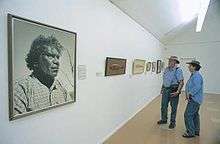
In 1934 Australian painter Rex Batterbee taught Aboriginal artist Albert Namatjira western style watercolour landscape painting, along with other Aboriginal artists at the Hermannsburg mission in the Northern Territory. It became a popular style, known as the Hermannsburg School, and sold out when the paintings were exhibited in Melbourne, Adelaide and other Australian cities. Namatjira became the first Aboriginal Australian citizen, as a result of his fame and popularity with these watercolour paintings.
In 1966, one of David Malangi's designs was produced on the Australian one dollar note, originally without his knowledge. The subsequent payment to him by the Reserve Bank marked the first case of Aboriginal copyright in Australian copyright law.
In 1988 the Aboriginal Memorial was unveiled at the National Gallery of Australia in Canberra made from 200 hollow log coffins, which are similar to the type used for mortuary ceremonies in Arnhem Land. It was made for the bicentenary of Australia's colonisation, and is in remembrance of Aboriginal people who had died protecting their land during conflict with settlers. It was created by 43 artists from Ramingining and communities nearby. The path running through the middle of it represents the Glyde River.[38]
In that same year, the new Parliament House in Canberra opened with a forecourt featuring a design by Michael Nelson Tjakamarra, laid as a mosaic.
The late Rover Thomas is another well known modern Australian Aboriginal artist. Born in Western Australia, he represented Australia in the Venice Biennale of 1990. He knew and encouraged other now well-known artists to paint, including Queenie McKenzie from the East Kimberley / Warmun region, as well as having a strong influence on the works of Paddy Bedford and Freddy Timms.
In the late 1980s and early 1990s the work of Emily Kngwarreye, from the Utopia community north east of Alice Springs, became very popular. Although she had been involved in craftwork for most of her life, it was only when she was in her 80s that she was recognised as a painter. Her works include Earth's Creation. Her styles, which changed every year, have been seen as a mixture of traditional Aboriginal and contemporary Australian. Her rise in popularity has prefigured that of many Indigenous artists from central, northern and western Australia, such as Kngwarreye's niece Kathleen Petyarre, Minnie Pwerle, Dorothy Napangardi, Lena Pwerle, Angelina Ngale (Pwerle) and dozens of others, all of whose works have become highly sought-after. The popularity of these often elderly artists, and the resulting pressure placed upon them and their health, has become such an issue that some art centres have stopped selling these artists' paintings online, instead placing prospective clients on a waiting list for work.[39]
Current artists in vogue include Jacinta Hayes, popular for her iconic representation of "Bush Medicine Leaves" and "Honey Ants", Rex Sultan (who studied with Albert Namatjira), Trephina Sultan and Reggie Sultan, Bessie Pitjara and Joyce Nakamara, amongst others.[40]
Despite concerns about supply and demand for paintings, the remoteness of many of the artists, and the poverty and health issues experienced in the communities, there are widespread estimates of an industry worth close to half a billion Australian dollars each year, and growing rapidly.[41]
Papunya Tula and "dot painting"
In 1971–1972, art teacher Geoffrey Bardon encouraged Aboriginal people in Papunya, north west of Alice Springs to put their Dreamings onto canvas. These stories had previously been drawn on the desert sand, and were now given a more permanent form.
The dots were used to cover secret-sacred ceremonies. Originally, the Tula artists succeeded in forming their own company with an Aboriginal Name, Papunya Tula Artists Pty Ltd,[42] however a time of disillusionment followed as artists were criticised by their peers for having revealed too much of their sacred heritage. Secret designs restricted to a ritual context were now in the market place, made visible to Australian Aboriginal painting. Much of the Aboriginal art on display in tourist shops traces back to this style developed at Papunya. The most famous of the artists to come from this movement was Clifford Possum Tjapaltjarri. Also from this movement is Johnny Warangkula, whose Water Dreaming at Kalipinya twice sold at a record price, the second time being $486,500 in 2000.
The Papunya Collection at the National Museum of Australia contains over 200 artifacts and paintings, including examples of 1970s dot paintings.[43]
Issues
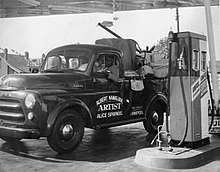
There have been cases of some exploitative dealers (known as carpetbaggers) that have sought to profit from the success of the Aboriginal art movements. Since Geoffrey Bardon's time and in the early years of the Papunya movement, there has been concerns about the exploitation of the largely illiterate and non-English speaking artists.
One of the main reasons the Yuendumu movement was established, and later flourished, was due to the feeling of exploitation amongst artists:
"Many of the artists who played crucial roles in the founding of the art centre were aware of the increasing interest in Aboriginal art during the 1970s and had watched with concern and curiosity the developments of the art movement at Papunya amongst people to whom they were closely related. There was also a growing private market for Aboriginal art in Alice Springs. Artists' experiences of the private market were marked by feelings of frustration and a sense of disempowerment when buyers refused to pay prices which reflected the value of the Jukurrpa or showed little interest in understanding the story. The establishment of Warlukurlangu was one way of ensuring the artists had some control over the purchase and distribution of their paintings."[44]
Other cases of exploitation include:
- painting for a lemon (car): "Artists have come to me and pulled out photos of cars with mobile phone numbers on the back. They're asked to paint 10-15 canvasses in exchange for a car. When the 'Toyotas' materialise, they often arrive with a flat tyre, no spares, no jack, no fuel." (Coslovich 2003)
- preying on a sick artist: "Even coming to town for medical treatment, such as dialysis, can make an artist easy prey for dealers wanting to make a quick profit who congregate in Alice Springs" (op.cit.)
- pursuing a famous artist: "The late (great) Emily Kngwarreye...was relentlessly pursued by carpetbaggers towards the end of her career and produced a large but inconsistent body of work." According to Sotheby's "We take about one in every 20 paintings of hers, and with those we look for provenance we can be 100% sure of." (op.cit.)
In March 2006, the ABC reported art fraud had hit the Western Australian Aboriginal Art movements. Allegations were made of sweatshop-like conditions, fake works by English backpackers, overpricing and artists posing for photographs for artwork that was not theirs. A detective on the case said:
"People are clearly taking advantage...Especially the elderly people. I mean, these are people that, they're not educated; they haven't had a lot of contact with white people. They've got no real basic understanding, you know, of the law and even business law. Obviously they've got no real business sense. A dollar doesn't really have much of a meaning to them, and I think to treat anybody like that is just… it's just not on in this country."[45]
In August 2006, following concerns raised about unethical practices in the Indigenous art sector, the Australian Senate initiated an inquiry[46] into issues in the sector. It heard from the Northern Territory Art Minister, Marion Scrymgour, that backpackers were often the artists of Aboriginal art being sold in tourist shops around Australia:
"The material they call Aboriginal art is almost exclusively the work of fakers, forgers and fraudsters. Their work hides behind false descriptions and dubious designs. The overwhelming majority of the ones you see in shops throughout the country, not to mention Darling, are fakes, pure and simple. There is some anecdotal evidence here in Darwin at least, they have been painted by backpackers working on industrial scale wood production."[47]
The inquiry's final report[48] made recommendations for changed funding and governance of the sector, including a code of practice.
Aboriginal art movements and cooperatives
Australian Indigenous art movements and cooperatives have been central to the emergence of Indigenous Australian art. Whereas many western artists pursue formal training and work as individuals, most contemporary Indigenous art is created in community groups and art centres.[49]
Many of the centres operate online art galleries where local and international visitors can purchase works directly from the communities without the need of going through an intermediary. The cooperatives reflect the diversity of art across Indigenous Australia from the north west region where ochre is significantly used; to the tropical north where the use of cross-hatching prevails; to the Papunya style of art from the central desert cooperatives. Art is increasingly becoming a significant source of income and livelihood for some of these communities.
Awards
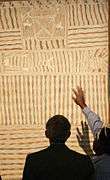
The winners of the West Australian Indigenous Arts Awards were announced on 22 August 2013. From over 137 nominations from throughout Australia, Churchill Cann won the Best West Australian Piece (A$10,000) and North Queensland artist Brian Robinson won the Best Overall prize (A$50,000).[50]
Traditional cultural expressions
The phrase "traditional cultural expressions" is used by the World Intellectual Property Organization to refer to "any form of artistic and literary expression in which traditional culture and knowledge are embodied. They are transmitted from one generation to the next, and include handmade textiles, paintings, stories, legends, ceremonies, music, songs, rhythms and dance."[51]
Aboriginal art in international museums
Australian Indigenous art has been much studied in recent years and has gained much international recognition.[52]
The Museum for Australian Aboriginal art "La grange" (at Neuchâtel, Switzerland) is one of the few museums in Europe that dedicates itself entirely to this kind of art. During seasonal exhibitions, works of art by internationally renowned artists are being shown. Also, the Musée du Quai Branly, Paris, has an "Oceania" collection,[53] which includes works by Australian Aboriginal artists Lena Nyadbi, Paddy Nyunkuny Bedford, Judy Watson, Gulumbu Yunupingu, John Mawurndjul, Tommy Watson, Ningura Napurrula and Michael Riley.[54]
Two museums that solely exhibit Australian Aboriginal art are the Museum of Contemporary Aboriginal Art (AMU), in Utrecht, The Netherlands and the Kluge-Ruhe Aboriginal Art Collection of the University of Virginia.[55][56]
See also
| Wikimedia Commons has media related to Australian Aboriginal art. |
- Art of Australia
- Australian Aboriginal fibre sculpture
- Contemporary Indigenous Australian art
- List of Indigenous Australian art movements and cooperatives
- List of Indigenous Australian visual artists
- List of Stone Age art
- Panaramitee Style
References
- Doring, Jeff Gwion Gwion: Chemins Secrets Et Sacrés Des Ngarinyin, Aborigènes D'Australie (Gwion Gwion: Secret and Sacred Pathways of the Ngarinyin Aboriginal People of Australia) Könemann 2000 ISBN 9783829040600 p. 55
- Worms, Ernest Contemporary and prehistoric rock paintings in Central and Northern North Kimberley Anthropos Switzerland 1955 p. 555
- "Rock Art Sites & Tours". Quinkan & Regional Cultural Centre. 2009. Retrieved 29 August 2013.
- Department of Sustainability, Environment, Water, Population and Communities (2012). "Ubirr art site". Australian Government. Retrieved 29 August 2013.CS1 maint: multiple names: authors list (link)
- Department of Sustainability, Environment, Water, Population and Communities (2013). "Rock art sites". Australian Government. Retrieved 29 August 2013.CS1 maint: multiple names: authors list (link)
- "Pre-history of Carnarvon Gorge". Australian Nature Guides. Archived from the original on 14 October 2013. Retrieved 29 August 2013.
- Rock Art Archived 1 August 2018 at the Wayback Machine, Aboriginal Art Online, retrieved April 2008.
- Masters, Emma (31 May 2010). "Megafauna cave painting could be 40,000 years old". Australian Broadcasting Corporation. Retrieved 29 August 2013.
- Akerman, Kim; Willing, Tim (March 2009). "An ancient rock painting of a marsupial lion, Thylacoleo carnifex, from the Kimberley, Western Australia". Antiquity. Retrieved 11 December 2012.
- Middleton, Amy; AAP (2 August 2013). "Aboriginal rock art may depict first sea arrivals". Australian Geographic. Archived from the original on 18 September 2013. Retrieved 29 August 2013.
- Department of Environment and Conservation (6 February 2013). "Creation of Western Australia's 100th National Park - Murujuga National Park". Government of Western Australia. Archived from the original on 21 April 2013. Retrieved 29 August 2013.
- "Fine Dot Paintings". Utopia Lane Art. Retrieved 21 November 2015.
- Morieson, J., 2003,”Solar-based Lithic Design in Victoria, Australia”, in World Archaeological Congress,Washington DC, 2003
- Timothy Cook, dancing with the moon. Frangos, Seva. Crawley, Western Australia. 2015. ISBN 9781742584980. OCLC 889871251.CS1 maint: others (link)
- "Tiwi Sculpture | Sell Tiwi Sculpture | Tiwi Carving | Tiwi artefact". Aboriginal Bark Paintings. 11 December 2017. Retrieved 10 January 2019.
- Kampen-O'Riley, M. (2006)
- Thomas, M., & Neale, M. (2011).
- "About weaving". Maningrida. 1 March 2017. Retrieved 25 January 2020.
- "History of Aboriginal and Torres Strait Islander textiles". archive.maas.museum. 9 April 2017. Retrieved 25 January 2020.
- Mills, Vanessa (21 July 2011). "Weaving magical baskets and sharing Aboriginal knowledge". ABC Kimberley. Australian Broadcasting Corporation. Retrieved 25 January 2020.
- "Ngarrindjeri basket weaving". Sustainable Communities SA. 24 August 2016. Retrieved 25 January 2020.
- Morphy, H., Rosenfeld, A., Sutton, P., Keen, I., Berndt, C. H., Berndt, R. M., . . . Cavazzini, F. (2003). Aboriginal Australia.
- Team AusEmade (28 September 2008). "Aboriginal Symbols". Ausemade.com.au. Retrieved 16 August 2013.
- "Art in the Torres Strait Islands". Japingka Aboriginal Art. Retrieved 20 January 2020.
- Whitford, Maddie (13 April 2020). "Producers reflect on profound experience walking with Indigenous artists on country". ABC News. Retrieved 14 April 2020.
- "Dance machines & headdresses". Awakening: Stories from the Torres Strait. Queensland Government. Retrieved 7 January 2020.
- "Dr Ken Thaiday Senior". Australia Council. 15 May 2019. Retrieved 14 April 2020.
- "Art Sets. Art of the Torres Strait Islands". New South Wales Art Gallery. Retrieved 20 January 2020.
- Brij V. Lal; Kate Fortune, eds. (2000). The Pacific Islands: An Encyclopedia. University of Hawaii Press. p. 456. ISBN 978-0-8248-2265-1. Retrieved 7 March 2016.
- Alfred Cort Haddon, along with one of his daughters, the pioneers in the modern study of Torres Strait string figures
- A string figure bibliography including examples from Torres Strait.
- Lawrie, Margaret Elizabeth (1970). Myths and Legends of the Torres Strait/collected and translated by Margaret Lawrie. Brisbane: University of Queensland Press.
- Lawrie, Margaret Elizabeth (1972). Tales from Torres Strait. St Lucia Qld: University of Queensland Press.
- Cambridge Anthropological Expedition to Torres Straits (1898); Hodes, Jeremy. Index to the Reports of the Cambridge Anthropological Expedition to Torres Straits; Haddon, Alfred C. (Alfred Cort), 1855–1940; Ray, Sidney Herbert, 1858–1939. Linguistics (1901), Reports of the Cambridge Anthropological Expedition to Torres Straits, University PressCS1 maint: multiple names: authors list (link)
- Robinson, Brian (2001). "Torres Strait Islander printmaking". Retrieved 7 January 2020 – via Centre for Australian Art: Australian Prints + Printmaking.
Conference paper, [from] Australian Print Symposium. Canberra: National Gallery of Australia, 1987 - ongoing
- "Alick Tipoti: Zugubal". Cairns Art Gallery. Retrieved 7 January 2020.
- Tipoti, Alick (2015), Butler, Sally (ed.), Alick Tipoti : Zugubal : ancestral spirits, Cairns Regional Gallery, ISBN 978-0-9757635-6-8
- Caruana, Wally (2003). Aboriginal Art (2nd ed.). London: Thames & Hudson. p. 226. ISBN 978-0-500-20366-8.
- Nazvanov, DR Greg. The Australian Aboriginal Art Investment Handbook, 2010.ISBN 1445776073
- Senate Standing Committee on the Environment, Communications, Information Technology and the Arts (2007), Indigenous Art: Securing the Future - Australia's Indigenous visual arts and craft sector, Canberra: The Senate
- "Papunya Tula Artists". Papunyatula.com.au. Retrieved 16 August 2013.
- Papunya Collection, National Museum of Australia. Retrieved 19 June 2011.
- "Warlukurlangu Artists". warlu.com. Archived from the original on 23 June 2005.
- Call for ACCC to investigate Aboriginal Art industry, ABC PM, 15 March.
- "Senate Committees (Page No Longer Valid)". www.aph.gov.au.
- "Backpackers fake Aboriginal art, Senate told". The Sydney Morning Herald. 21 February 2007.
- "Senate Committees (Page No Longer Valid)". www.aph.gov.au.
- Wright, Felicity and Morphy, Frances 1999-2000. The Art & Craft Centre Story. Canberra: ATSIC (3 vols).
- Craig Quartermaine (23 August 2013). "Winner of the West Australian Indigenous Art prize announced". SBS World News Australia. Retrieved 28 August 2013.
- Zuckermann, Ghil'ad; et al. (2015), ENGAGING - A Guide to Interacting Respectfully and Reciprocally with Aboriginal and Torres Strait Islander People, and their Arts Practices and Intellectual Property (PDF), Australian Government: Indigenous Culture Support, p. 7, archived from the original (PDF) on 30 March 2016
- Caruna, W.(2003)'Aboriginal Art' Thames and Hudson, London, iiii p.7
- "musée du quai Branly: Oceania". Quaibranly.fr. Archived from the original on 6 March 2014. Retrieved 16 August 2013.
- "Musée du Quai Branly Australian Aboriginal Art Museum at the Aboriginal Art Directory. View information about Musée du Quai Branly". Aboriginalartdirectory.com. 15 July 2010. Retrieved 16 August 2013.
- "Home". AAMU. AAMU. August 2013. Archived from the original on 9 September 2013. Retrieved 28 August 2013.
- "The Kluge-Ruhe Aboriginal Art Collection". Campaign for the Arts at the University of Virginia. Rector & Visitors, U.Va. August 2013. Archived from the original on 28 August 2013. Retrieved 28 August 2013.
Further reading
- Bardon, G. (1979) Aboriginal Art of the Western Desert, Adelaide: Rigby
- Bardon, G. (1991) Papunya Tula: Art of the Western Desert, Ringwood VIC: McPhee Gribble (Penguin)
- Bardon, G. (2005) Papunya, A Place Made After the Story: The Beginnings of the Western Desert Painting Movement, University of Melbourne: Miegunyah Press
- Den Boer, E. (2012). Spirit Conception: Dreams in Aboriginal Australia [PDF]. American Psychological Association
- Donaldson, Mike, Burrup Rock Art: Ancient Aboriginal Rock Art of Burrup Peninsula and Dampier Archipelago, Fremantle Arts Press, 2010. ISBN 978-0-9805890-1-6
- Flood, J. (1997) Rock Art of the Dreamtime:Images of Ancient Australia, Sydney: Angus & Robertson
- Johnson, V. (ed) (2007) Papunya painting: out of the desert, Canberra: National Museum of Australia
- Kampen-ORiley, M. (2006). Art beyond the West. Upper Saddle River, NJ: Prentice Hall.
- Kleinert, S. & Neale, M. (eds.) (2000) The Oxford Companion to Aboriginal Art and Culture, Melbourne: Oxford University Press
- McCulloch, S. (1999) Contemporary Aboriginal Art: A guide to the rebirth of an ancient culture, St Leonards (Sydney): Allen & Unwin
- McIvor, Roy (2010). Cockatoo: My Life in Cape York. Stories and Art. Roy McIvor. Magabala Books. Broome, Western Australia. ISBN 978-1-921248-22-1
- Morphy, H. (1991) Ancestral Connections, London: University of Chicago Press
- Morphy, H. (1998) Aboriginal Art, London: Phaidon Press
- Myers, F. R. (2002) Painting Culture: The making of an Aboriginal High Art, Durham: Duke University Press
- Rothwell, N. (2007) Another Country, Melbourne: Black Inc.
- Ryan, M.D. and Keane, M. and Cunningham, S. (2008) Indigenous Art: Local Dreamings, Global Consumption, in Anheier, Helmut and Raj Isar, Yudhishthir, Eds. Cultures and Globalization: The Cultural Economy, London: Sage Publications, pp. 284–291
- Senate Standing Committee on the Environment, Communications, Information Technology and the Arts (2007), Indigenous Art: Securing the Future – Australia's Indigenous visual arts and craft sector, Canberra: The Senate
- Wright, F. (with Morphy, F. and Desart Inc.) (1999–2000) The Art and Craft Centre Story (3 vols), Woden: Aboriginal and Torres Strait Islander Commission
- Kampen-ORiley, M. (2006). Art beyond the West. Upper Saddle River, NJ: Prentice Hall.
- Thomas, M., & Neale, M. (2011). Exploring the legacy of the 1948 Arnhem Land expedition. Camberra: ANU E Press.
- Morphy, H., Rosenfeld, A., Sutton, P., Keen, I., Berndt, C. H., Berndt, R. M., . . . Cavazzini, F. (2003). Aboriginal Australia. Retrieved 2018, from 73
External links
| Wikimedia Commons has media related to Australian Aboriginal art. |
| Library resources about Indigenous Australian art |
- Indigenous Art Code, the industry code set up to promote integrity, transparency and accountability in dealing with Indigenous art
- Aboriginal Art Directory, a comprehensive list of art centres, museums, galleries, along with Aboriginal art news and reviews
- "Artists in the Black". Arts Law Centre of Australia. 18 January 2019.
- Association of Northern, Kimberley and Arnhem Aboriginal Artists
- Australian Indigenous Art Trade Association
- National Aboriginal & Torres Strait Islander Art Award: History
- Culture Victoria – images and videos related to traditional art and artefacts
- Australian Art Collector magazine's Guide to Indigenous Art Centres
- Lockhart River Art
- Remembering Forward. Australian Aboriginal Painting since 1960 at Museum Ludwig, Cologne, Germany
- Discussion on Country, memory and art: Understanding Indigenous art, Howard Morphy, John Carty and Dr Michael Pickering, National Museum of Australia, Audio on demand, 8 December 2010
- Papunya Painting: Out of the Desert, National Museum of Australia online exhibition
- Aboriginal Art Museum of Utrecht
